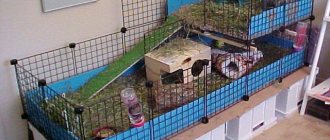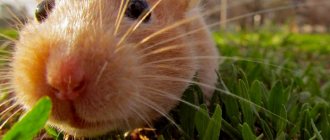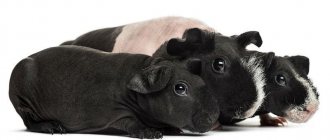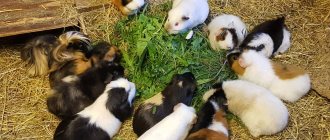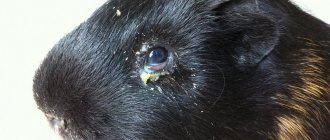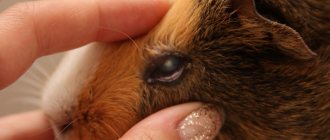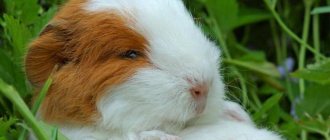- home
- Guinea pig
- General information about guinea pigs
02/18/2019 For people, vision is one of the most important senses of perceiving the world. But is this true for guinea pigs? Can animals go blind and continue to lead a full life? The information presented will help you find out how these animals see the surrounding reality, and what needs to be done to preserve their vision.
Guinea pig visual organs
First of all, it is worth noting the presence of fairly large eyes on the sides of the animal’s head. Thanks to this peculiarity of the location of the eyes, the animal can see what is happening from a greater angle than a person. Also, such a radius of vision of the animal allows it to instantly detect danger and react to it. Despite the fact that the pet's vision has not been fully studied, many signs make it clear that he can see objects in color. It is able to distinguish a range of shades and also reacts to moving objects.
A special feature of a guinea pig's eyes is that they can simultaneously see objects to the right and to the left of themselves.
According to recent research, pigs can distinguish the following colors:
- green;
- red;
- blue;
- yellow.
This vision feature helps the pet better distinguish food. Myopia is considered another congenital feature of a pet, therefore the emphasis in the process of survival is often placed on other organs, for example, hearing or smell, but these organs will be discussed below.
What colors does a rodent distinguish?
As a result of research in the field of rodentology, scientists have proven that guinea pigs have color vision that is more developed than that of dogs and cats. Pigs have several primary colors, namely: green, yellow, blue and red.
They use this ability to determine the edibility of food. For example, if you put a leaf of lettuce without a herbal smell in the cage, the pig will find it without problems, focusing on the color of the greenery.
Ways to see a pig in the dark
Like other rodents, guinea pigs have good orientation and vision in dark rooms. Despite the virtual absence of helplessness at night and the ability to perform basic operations, vision in rodents is still considered daytime. Because of this, it is ideal to place the cage in a well-lit area, but away from direct sunlight. Experiments have been conducted to prove the negative influence of darkness on the animal. Degradation, disease, and mutations of various types occur. It has been noted that in the process of survival, animals are better oriented in space thanks to hearing and smell rather than vision.
What you need to pay attention to
There is no escape route in a guinea pig cage or enclosure, so the responsibility for the animals' peaceful life together falls on you. Please note the following.
For young males, once they reach sexual maturity, that is, no later than 4-5 weeks, other owners should be found. This is necessary not only to avoid clashes, but also to prevent uncontrolled further reproduction.
If a male is defeated in the struggle for a dominant place in the family, he must be immediately placed in another enclosure, otherwise he will wither away, since there is no longer room for him in the family.
A young castrated male placed with a group of females will probably not be able to immediately establish himself as a host. The situation will change only over time, when he grows up and exceeds the females in size and weight.
Related article: Do guinea pigs bite or not? What to do if you are bitten until you bleed and how to stop a rodent from biting
A guinea pig that avoids its own guinea pigs has probably had no contact with other guinea pigs from an early age, causing it to lack a sense of belonging to the group and therefore having a very difficult time getting along with its fellow guinea pigs.
If you want to place a group of guinea pigs in a new cage with other guinea pigs, then feel free to do so. It is more difficult to place a guinea pig kept separately with several animals, among which it will have to get along. In addition, several animals need a larger cage.
Possible problems with the organs of vision
Despite the poorly developed organs of vision, pigs have no problems with it. This does not happen often and is usually a side effect of respiratory diseases. Such problems can also indicate diabetes, dental disease and general dehydration of the animal. A sign of vision problems is the presence of discharge from the eyes, and the pupil becomes cloudy. The quality of general vision decreases, the animal is less oriented in space.
Due to damage to vision, the animal may begin to develop a corneal ulcer. If the rodent's eyes are swollen and watery, and the animal itself behaves restlessly, you should consult a veterinarian. Cataracts are age-related changes or a consequence of diabetes. Sometimes animals are already born blind, but thanks to well-developed other organs and with a high-quality standard of living and care, they are no different from their brothers.
Preventing vision problems in your pet
To keep your guinea pig healthy and sighted, you need to take into account its lifestyle and follow a few simple recommendations:
- Males should be kept separately, since each should have their own territory, otherwise two boys will conflict and chase each other around the cage (as a result, injuries and bites may occur).
- You should not place a lot of dry twigs or coarse straw in the cage so that the animal can move around calmly without the risk of injuring itself.
- The owner should periodically inspect the eyes and clean the fur around them if discharge appears.
- For the treatment and care of the eyes, you can use only veterinary drugs suitable for rodents (from your first aid kit, only Levomycetin eye drops are considered acceptable).
- The cage should be placed in a bright and cool place (pigs need daylight).
- Upon reaching old age (after 5 years), the pet should be periodically shown to a veterinarian in order to recognize possible vision problems and begin timely treatment.
Vision for guinea pigs is not the main sense organ, however, it helps them quickly navigate in space and escape from natural enemies (owls and other predators). In addition, breeders consider animals with unusual eye colors, such as blue or ruby, to be the most valuable, which makes them even more cute and attractive.
Timely vision testing and care
The initial vision test and consultation should be with a veterinarian. In order not to start the process, you need to pay as much attention to your pet as possible. If problems are detected, you should immediately contact your veterinarian.
The more often the owner has contact with the animal, taking it in his arms, the sooner and more timely it will be possible to detect the following signs:
- cloudy pupil;
- film formation;
- redness of the eyelids;
- discharge from the eyes;
- rolled up eyelid or its unnatural position;
- unnatural protrusion of the eyeball.
You can check an animal for blindness by bringing an object to it in an unexpected way. If the animal sees, at a minimum it will react to the danger and twitch. In blind pets, the reaction to danger and the instinct of self-preservation do not work.
Because the pet’s vision is not very good, it is important for the owner to remember several basic criteria for creating proper care:
- If you suspect vision problems, you should immediately, without delay, go to the veterinarian. And do not speculate and prolong the course of the disease. The activity of the animal does not mean good vision. In the surrounding world, pigs navigate with the help of other organs, which misleads owners, especially inexperienced ones.
- It is not recommended to place the cage in a too dark place, or under a lamp. Direct sunlight on the cage also negatively affects the animal's vision.
- Observe the animal more carefully, especially in open spaces. If there is blindness, but it is not detected, the animal can harm itself.
In addition to vision, the animal has other developed organs, but much better.
Possible pathologies
Guinea pigs' eyes are not protected; they do not have nictitating membranes, which makes them vulnerable to various diseases.
The most common eye pathologies are:
- Cataracts (or clouding of the lens) that develop in older pigs (over 5 years of age).
- Conjunctivitis is an inflammatory phenomenon of the mucous membrane, as a result of which purulent discharge appears, the exudate dries out, crusts form, stick to the fur, and the eyelids stick together. The disease can be contagious if several animals live in the house and constantly communicate with each other.
- Corneal ulcer. Occurs when a mechanical injury to the eye occurs and there is no treatment.
- Blindness from birth is rare, but it is associated with defects in animal breeding.
- Fat eye is a hereditary pathology, characterized by protrusion of the eyes from the orbit, and cannot be treated.
- Retrobulbar abscess is an inflammation that develops when teeth grow into the eye socket. Occurs when improper feeding and the absence of hard objects to grind down the teeth in the animal’s cage.
Olfactory organs
The main task of the olfactory organs is to help the pig communicate with relatives and find a mate to satisfy sexual instincts. Like many mammals, in pigs urine plays the role of marking territory and attracting partners of the opposite sex. In males, urine means a call for mating, while the female may respond by refusing the male. First of all, animals are guided by their olfactory organs and are able to recognize each other in a pack by smell. Shy behavior when meeting people is the norm for guinea pigs. Pigs have a more acute sense of smell than humans. It is developed 1000 times more powerful than in ordinary people.
How to check and prevent damage to your pet's vision
Only a veterinarian can guarantee healthy vision or diagnose disease. The owner can only monitor the appearance of the pet on his own and notice signs of pathology in time:
- redness of the eyes;
- cloudy discharge;
- unnatural position of the eyelid;
- clouding of the pupil;
- twitching or protrusion of the eyeball;
- film formation.
If one or more signs appear, you should take your pet to the veterinarian. Some owners mistakenly believe that if the pig continues to behave naturally, this means that everything is fine. In fact, the pet quickly adapts to decreased visual acuity thanks to other well-developed senses. But if warning signs are left unaddressed, they can lead to a serious illness that affects the entire body, not just the eyes.
Organs of touch
The organs of touch in pigs are the antennae located on the muzzle. These antennae help the pet navigate even in the dark and sense danger nearby. While an animal's sense of smell may fail, they can easily detect food or the presence of obstacles using their sense of touch. At the same time, along with instincts, the animal uses previously accumulated experience. For example, it easily distinguishes high-quality food from unsuitable food. By the way, it was thanks to this feature that it was possible to establish the animals’ love for sweet food.
How to check and prevent damage to your pet's vision
There are signs by which you can determine the presence of eye problems:
- clouding of the pupil or formation of a film;
- eye twitching;
- redness of the eyelids, discharge from the eye;
- protrusion of the eyeball or unnatural position of the eyelid.
If any of these signs are detected, you should take your pet to a doctor. They do not go away on their own. In addition, some owners mistakenly consider their pet to be sighted if it continues to navigate well in the cage - it finds a bowl or a sleeping place. They do this through their sense of smell rather than their vision.
In order not to worsen the rodent’s already poor vision, you should not place the cage next to sources of artificial light or under direct sunlight. Too dark places are also undesirable.
If the animal has already begun to go blind, then when releasing it from the cage you need to be extremely vigilant so that it does not accidentally harm itself. Blind pigs can lead fulfilling lives, but this is not a reason to take warning signs lightly. An eye problem may be a consequence of another, more serious illness.
Viral diseases
What diseases in guinea pigs can be caused by viruses? The most dangerous viral pathologies are paralysis and pestilence. Such diseases are manifested by convulsions and paralysis of the limbs. The animal must be taken to the veterinarian immediately.
Symptoms of other viral diseases include:
- diarrhea;
- matted fur;
- unusual behavior;
- nasal discharge.
Among the bacterial diseases, it is worth noting pseudotuberculosis, in which the guinea pig experiences frequent diarrhea, causing severe exhaustion. This disease is contagious, so the animal must be isolated so that the others do not die.
Origin
The animals are of South American origin. Pigs living in natural conditions are most widespread in Peru and Chile. In the territories of these countries, wild rodents are found:
It was from South America that pigs came, thanks to Columbus, to Europe. Europeans quickly fell in love with the strange animals and soon turned from an animal with delicious meat into pets.
In the scientific world, these rodents are designated by the Latin word “cavia”. The name “guinea pig” was assigned to the animals not by scientists, but by ordinary people. “Pig” - because it grunts. “Sea” - because she arrived from the other end of the world, from across the sea.
Domesticated animals do not like water. They should be bathed as rarely as possible. And even more so, you shouldn’t let the animal just swim. Once in the water, a land rodent experiences stress and may even drown or choke from fright.

